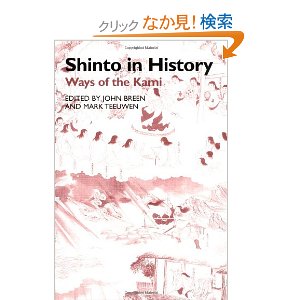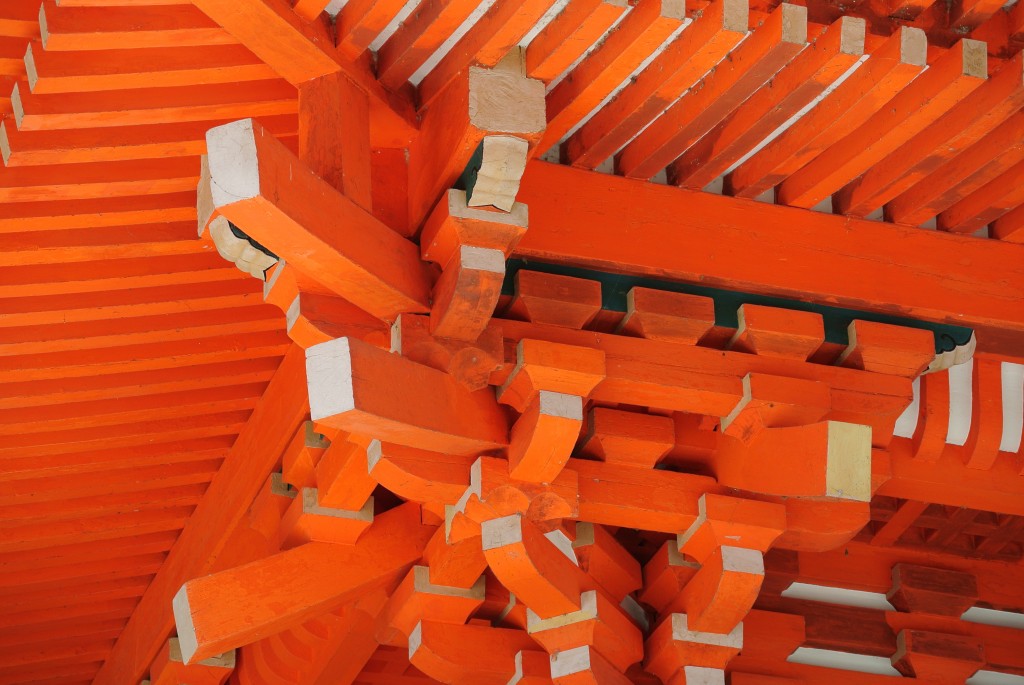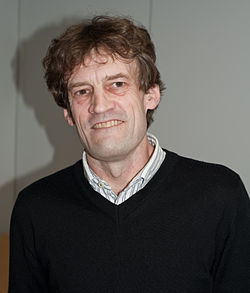I’m reposting this review from the Japan Times (originally in Monumenta Nipponica) because I think it’s important… As the review title suggests, the book has to do with common misperceptions about Shinto…
*********************************************************************************
SHINTO IN HISTORY: Ways of the Kami, edited by John Breen and Mark Teeuwen. Richmond, Surrey, U.K.: Curzon Press, 1999, 368 pp.
Dismantling stereotypes surrounding Japan’s sacred entities
Reviewed by FABIO RAMBELLI (Sunday, July 15, 2001)
 “Shinto in History: Ways of the Kami” is the first attempt in any Western language (and possibly even in Japanese) to offer a critical examination of the Shinto tradition in its various aspects and guises. It constitutes a powerful critical and analytical tool to counter widely circulating textbook-like treatments of the subject.
“Shinto in History: Ways of the Kami” is the first attempt in any Western language (and possibly even in Japanese) to offer a critical examination of the Shinto tradition in its various aspects and guises. It constitutes a powerful critical and analytical tool to counter widely circulating textbook-like treatments of the subject.
Shinto is often presented as the indigenous religion of Japan, a cultural formation that supposedly has existed in an almost unchanged form from the remotest past as the unique expression of the Japanese polity and that is characterized, among other things, by a close relation with nature.
One of the aims of the book, as is clear from the subtitle, is precisely the dismantling of such stereotypical views. “Ways of the Kami” suggests a plurality of modes of interpretation of and interaction with sacred entities — the kami — a term that is itself to be understood in the plural. Far from being a simple and unified tradition, as is often assumed, Shinto is presented here as a complex and diverse entity.
Historicity is a fundamental component of the editors’ view of Shinto, as the title indicates. The structure of the book, which follows a strictly chronological order, further underlines the historical emphasis. This should not, however, be understood as a form of historicism, in which each essay describes a stage in the unilinear evolution of Shinto.
To the contrary, all the essays show — in their subjects, methodologies and broader theoretical concerns — the diversity and complexities inherent in the kami traditions of Japan. The individual articles can be envisioned as pieces of an evolving mosaic that does not have a clear thematic center but grows more complicated and intricate over time.

The Ways of the Kami are multiple and complicated
The generative matrix of the book derives from a seminal article by Toshio Kuroda entitled “Shinto in the History of Japanese Religion,” originally published in English in 1981. The editors underline the enormous importance of this article, which argued that Shinto as an independent religion took shape only in the modern period, having emerged in the medieval age as an offshoot of Buddhism.
The introductory essay, “Shinto Past and Present,” by the two editors, John Breen and Mark Teeuwen, despite its relative shortness, well deserves to be included in course readers on Japanese religions as a healthy alternative vision to traditional textbook stereotypes.
Another essay, “Shinto as a ‘Non-religion’: The Origins and Development of an Idea,” by Hitoshi Nitta, presents the origins of the idea, still widely circulating, that Shinto is not a religion but a set of customs, rituals and beliefs related to ancestor cults, the emperor or the state. “The Structure of State Shinto: Its Creation, Development and Demise,” by Koremaru Sakamoto, argues, in my opinion unconvincingly, that wartime State Shinto was a “faithless” movement without “contact with the mystery of the sacred spirits,” that is, that it had little to do with a supposedly real Shinto. He holds at the same time it was “far removed . . . from the ideologies of ‘ultranationalism,’ ‘expansionism’ and ‘militarism.’ ”
“Tanaka Yoshito and the Beginnings of ‘Shintogaku,’ ” by Junichi Isomae, traces the modern development of Shinto studies as an academic discipline originally animated by xenophobic and authoritarian concerns. The book concludes with a useful general bibliography and index.
The abundant materials and references make this book a rich source of suggestions for future research. For example, the interaction between traditions “native” to the Japanese archipelago and “foreign” religions (not just Taoism and Buddhism, but also Confucianism and, why not, Christianity) deserves a more systematic study. The same can be said about traditional state cults and their relation with modern “state religion.” A more general, theoretical problem is the impact of premises from the modern academic field of religious studies on the definition and study of Shinto, as seen, for instance, in the fact that Shinto rituals are often denied the status of religious activities, instead defined as “customs.”
This is an important, groundbreaking book. For its plurality of topics, approaches and perspectives, its scholarly soundness and its genuine international sensibility (it was written by scholars from a half-dozen countries), it will become required reading in courses on Japanese history, culture and religion. It will be the reference text on Shinto studies for years to come, and it well deserves to be translated into Japanese.
This review is excerpted from Monumenta Nipponica, 56:2.


I was at my local University library the other day and came across a recently added Shinto related book, wondered if you’ve seen it or know anything about it? (I didn’t have time to check it out properly, unfortunately…)
Steven Heine, Sacred High City, Sacred Low City: a tale of sacred sites in two Tokyo neighborhoods
Hi Erik and thanks for drawing notice to the book. I didn’t know about it, but found a useful online review which claims it is a ‘must-read’ for anyone interested in the survival of religious practice in a secular and postmodern Japan. See http://religion.fiu.edu/news/2011/heine-book/
Excellent! I shall have to renew my community borrower card and read that one – thanks for the link. If/when I get it done I’ll let you know my impressions.